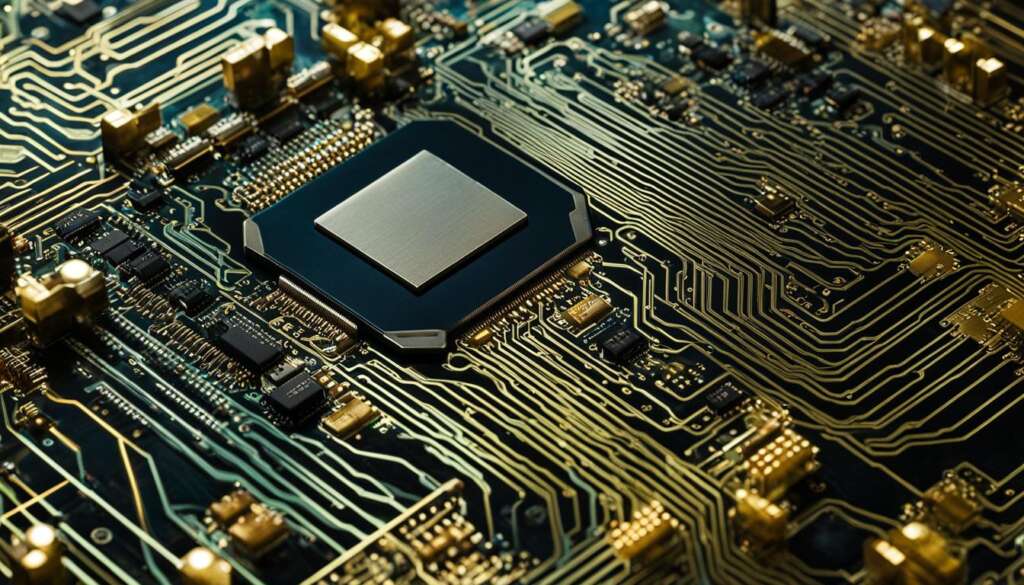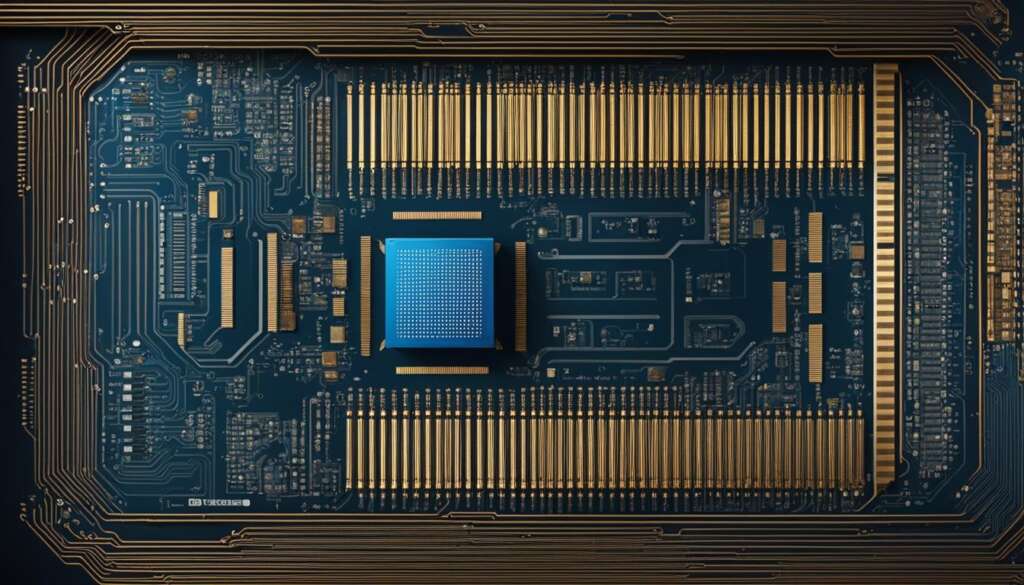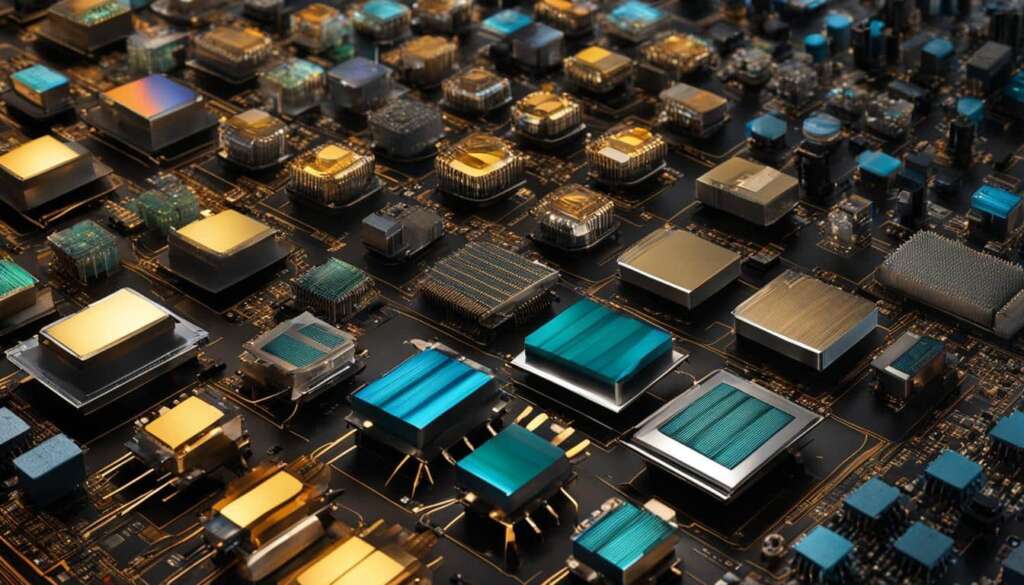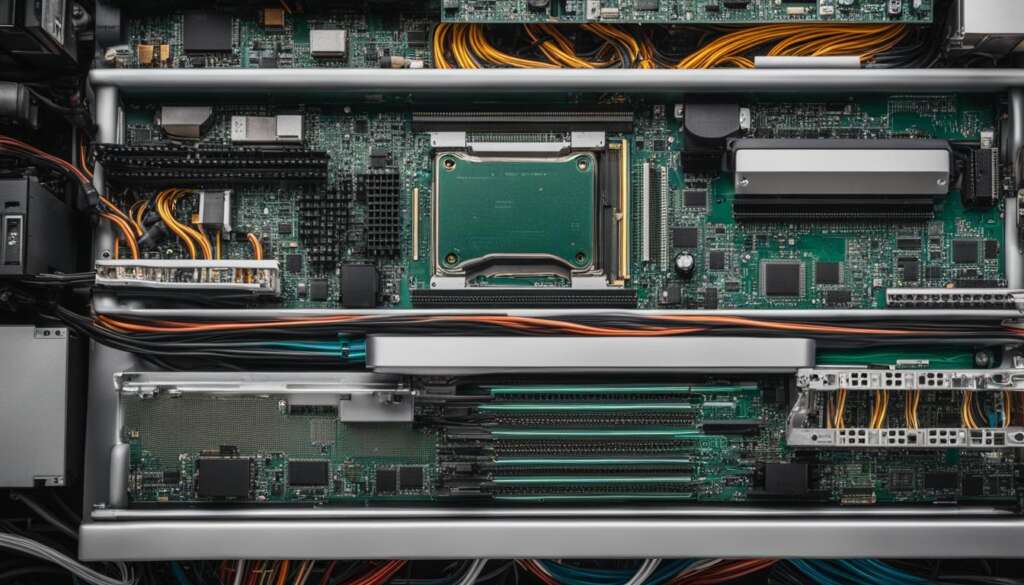Table of Contents
Welcome to our article exploring the fascinating world of transistor technology. Transistors have played a pivotal role in revolutionizing computer technology and driving the digital age. From their architecture and design to the manufacturing process and performance, these electronic wonders have transformed our world in countless ways.
As the backbone of integrated circuits (ICs) and microprocessors, transistors enable the development of computers, smartphones, and other electronic devices that have become indispensable in our daily lives. They have made devices smaller, faster, more efficient, and less power-consuming, propelling technology forward in astounding ways.
In this article, we will delve into the applications, innovations, and advancements of transistors, exploring their significant impact on the industry and market trends. Join us as we uncover the fascinating intricacies of transistor technology and its role in shaping our digital future.
What is a Transistor and Why is it Important?
A transistor is a crucial component in the field of electronics. It is a three-layer semiconductor device that can regulate and amplify electrical signals, acting as a switch or an amplifier. Transistors play a fundamental role in the creation of integrated circuits (ICs) and microprocessors, which form the backbone of modern electronic devices. They are deeply embedded in nearly all electronic devices, enabling their functionality and powering various applications.
Transistors are essentially electronic switches that open and close gates, controlling the flow of current or voltage. They can be combined to form logic gates, enabling decision-making processes in computers and digital devices. Additionally, transistors act as amplifiers, enhancing the strength of weak electrical signals. This amplification is particularly important in applications like FM receivers, where the quality of the received signal greatly depends on the transistor’s performance.
The importance of transistors in electronic devices cannot be overstated. They allow for the miniaturization of electronic systems, making devices smaller, faster, and more efficient. With the advancements in transistor technology, electronic devices have become more powerful and portable, revolutionizing various industries and improving everyday life. Power supply inverters, oscillator circuits for generating radio signals, and countless other applications rely on the functionality and performance of transistors.
Table: Applications of Transistors in Electronic Devices
| Device | Application |
|---|---|
| Computers | Logic gates for decision-making, microprocessor functionality |
| Smartphones | Signal amplification, processor control |
| Televisions | Signal processing, audio and video amplification |
| Medical devices | Data acquisition, signal processing |
| Automotive electronics | Engine control, power management |
Transistors are at the core of modern technology, driving advancements in computing power, communication systems, and various other fields. As the demand for smaller, faster, and more efficient electronic devices continues to grow, the importance of transistors remains paramount.
How Transistors Revolutionized Technology
Transistors have revolutionized technology since their invention in 1947. With their introduction, bulky vacuum tubes were quickly replaced, leading to a trend of miniaturization in electronics. Compared to vacuum tubes, transistors were significantly smaller, lighter, more efficient, and consumed less power. This breakthrough in transistor technology fueled advancements in various fields, making electronic systems smaller, faster, and more efficient.
The miniaturization of electronic devices made possible by transistors has had a profound impact on the world. Computers that used to occupy entire rooms now fit in our pockets, thanks to the remarkable shrinking of transistors. The increased efficiency and decreased power consumption of transistors have also contributed to cost reductions, making technology more accessible and affordable to a wider range of people.
Furthermore, transistors have paved the way for numerous other technological advancements. They are the building blocks of integrated circuits (ICs) and microprocessors, enabling the development of computers, smartphones, and other electronic devices that have become indispensable in our daily lives. Transistors are used in a myriad of applications, from power supply inverters to oscillator circuits for generating radio signals. Their invention has truly transformed technology and set the stage for continuous innovation.
The Impact of Transistors:
- Miniaturization of electronic devices
- Increased efficiency and reduced power consumption
- Cost reductions, making technology more accessible
- Development of computers, smartphones, and other electronic devices
- Wide range of applications in various industries
Transistors have had a profound and lasting impact on technology, enabling the development of smaller, faster, and more efficient electronic devices. Their invention sparked a revolution that led to the miniaturization of computers and other electronic systems. The increased efficiency and reduced power consumption of transistors have not only made technology more affordable but also paved the way for countless other technological advancements. As transistors continue to evolve, we can expect even more exciting developments that will shape the future of technology.
The Basics of Transistors and How They Work
Transistors are essential components in modern electronic devices, serving as switches and amplifiers that enable the functionality of these devices. They play a crucial role in various applications, from simple logic gates to complex signal processing. Understanding the basics of transistors and how they work is key to comprehending their significance in the world of technology.
Transistors can function as switches, controlling the flow of current through electronic gates. When a small current is applied to the base terminal of a transistor, it allows a larger current to flow through the collector and emitter terminals. This property of transistors makes them ideal for binary logic operations, where a low current can represent a logical “0” and a high current can represent a logical “1”. By combining multiple transistors, logic gates can be created to perform various operations, such as AND, OR, and NOT.
Transistors also act as amplifiers, increasing the strength of weak signals. When a small input signal is applied to the base terminal, the transistor amplifies it to produce a larger output signal at the collector terminal. This amplification property is used in various applications, such as audio amplifiers and radio receivers, where weak signals need to be boosted for proper detection or reproduction.
The functionality of transistors relies on their ability to control the movement of electrons or holes within the semiconductor material. By manipulating the current flow through the base terminal, transistors can regulate the behavior of electronic circuits, making them a fundamental building block of modern electronic systems.
Table: Transistor Functionality
| Function | Description |
|---|---|
| Switching | Transistors can act as electronic switches, controlling the flow of current through gates to perform logical operations. |
| Amplification | Transistors amplify weak signals, increasing their strength for clearer detection or reproduction. |
| Logic Gates | Multiple transistors can be combined to create logic gates, enabling binary operations. |
| Signal Processing | Transistors play a crucial role in amplifying and processing electronic signals for various applications. |
By harnessing the unique properties of transistors, engineers and scientists have been able to revolutionize technology and create the advanced electronic devices we rely on today. From computers and smartphones to televisions and medical equipment, transistors are the backbone of modern technology, driving innovation and progress in an increasingly interconnected world.
Understanding the Parts and Types of Transistors
Transistors, the fundamental components of modern electronic devices, consist of three terminals: the emitter, base, and collector. Each terminal plays a crucial role in the functionality of the transistor.
The emitter emits electrons or charge carriers into the transistor. It is responsible for initiating the flow of current within the transistor.
The base controls the current flow and acts as a switch. By applying a small current or voltage to the base, the transistor can regulate the flow of charge carriers from the emitter to the collector.
The collector collects the carriers sent by the emitter and allows them to exit the transistor. It completes the circuit and enables the flow of current through the transistor.
Transistors can be classified into two major types: NPN (Negative-Positive-Negative) and PNP (Positive-Negative-Positive) transistors.
In an NPN transistor, electrons pass from the emitter to the base and are collected by the collector. It operates by using the majority charge carriers, which are electrons.
On the other hand, in a PNP transistor, the flow of charge carriers is reversed. The base controls the flow of holes (the majority charge carriers) from the emitter to the collector. PNP transistors are commonly used in applications where a positive current control is desired.
Now, let’s take a closer look at the different types of transistors:
NPN Transistor:
An NPN transistor is a three-layer semiconductor device with a middle p-type layer sandwiched between two n-type layers. It offers excellent amplification capabilities and is widely used in applications such as signal amplification and switching circuits. NPN transistors are commonly found in electronic devices, including radios, televisions, and computers.
PNP Transistor:
A PNP transistor is also a three-layer semiconductor device, but with a different arrangement. It has a middle n-type layer sandwiched between two p-type layers. PNP transistors are commonly used in applications that require low-power amplification and are commonly found in audio and power control circuits.
| Transistor Type | Structure | Application |
|---|---|---|
| NPN Transistor | n-p-n | Signal amplification, switching circuits |
| PNP Transistor | p-n-p | Low-power amplification |
Evolution of Transistor Technology and Manufacturing Process
The evolution of transistor technology has been remarkable, with significant advancements in design and manufacturing processes. From the early days of planar transistors to the latest developments in FinFET and gate-all-around (GAA) transistors, the industry has consistently pushed the boundaries of what is possible. These advancements have paved the way for more efficient and powerful transistors that are essential in driving technological progress.
Planar transistors, introduced in the early years, paved the way for miniaturization and improved performance. However, as technology advanced, the limitations of planar transistors became evident. This led to the development of FinFET transistors, which introduced a 3D structure that significantly improved performance and reduced leakage current. By controlling the flow of electrons on multiple sides of the transistor’s fin, FinFETs allowed for better control and enhanced efficiency.
The latest breakthrough in transistor technology is the gate-all-around (GAA) transistor. This transistor architecture takes 3D transistors to the next level by completely surrounding the channel region with the gate. The GAA structure provides even greater control over the flow of electrons, resulting in improved performance, reduced power consumption, and better scalability.
The manufacturing process for these advanced transistors involves a series of intricate steps. It starts with the creation of silicon wafers, followed by techniques like oxidation, photolithography, etching, and doping. These processes ensure the precise formation of transistor components and the introduction of impurities to control conductivity. The continuous refinement of manufacturing processes has allowed for the development of smaller, more powerful, and energy-efficient transistors.
Evolution of Transistor Technology
| Transistor Type | Advancements |
|---|---|
| Planar Transistors | – Introduction of miniaturization – Improved performance |
| FinFET Transistors | – 3D structure for better control – Enhanced performance and efficiency |
| Gate-All-Around (GAA) Transistors | – Complete surrounding of the channel region with the gate – Improved performance, power consumption, and scalability |
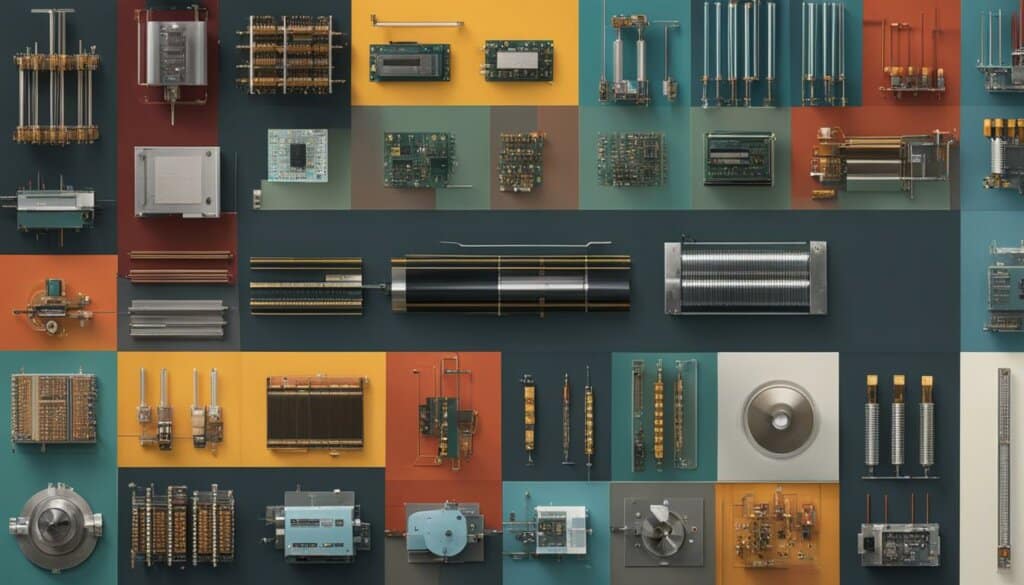
The evolution of transistor technology has revolutionized the electronics industry, enabling the development of smaller, more powerful devices. As the demand for faster and more efficient electronic systems continues to grow, the transistor industry will undoubtedly push the boundaries of what is possible, leading to further advancements in performance, energy efficiency, and manufacturing processes.
Materials and Manufacturing Process of Transistors
In the world of transistor technology, the choice of materials and the precise manufacturing process are crucial in harnessing the full potential of these tiny semiconductor wonders. Silicon, with its exceptional semiconductor properties, is the material of choice for the majority of transistors. Its wide availability, stability, and compatibility with existing manufacturing techniques make it the go-to material for transistor production.
The manufacturing process of transistors involves a series of intricate steps, starting with the creation of silicon wafers. These wafers undergo various techniques like oxidation, photolithography, etching, and doping to shape them into functional transistors. Doping, in particular, is a critical step that introduces impurities into the silicon, altering its conductivity and enabling transistor functionality.
Advancements in materials and manufacturing processes have driven the development of increasingly smaller and more powerful transistors. The ability to create thin-body transistors has opened up new possibilities for miniaturization and improved performance. With ongoing research and technological progress, the future holds even more exciting potential for the materials and manufacturing processes of transistors.
| Materials | Manufacturing Process |
|---|---|
| Silicon | – Creation of silicon wafers |
| – Techniques: oxidation, photolithography, etching, and doping | |
| – Doping introduces impurities to change conductivity | |
| – Advancements enable smaller and more powerful transistors |
By carefully selecting materials and refining the manufacturing process, scientists and engineers are pushing the boundaries of transistor technology. These advancements have profound implications for various industries, enabling the creation of smaller, faster, and more energy-efficient electronic devices. As silicon and other materials continue to evolve, and manufacturing processes become more refined, we can look forward to a future where transistors play an even more integral role in shaping the world of technology.

The Future of Transistors: Thin-Body Transistors
One exciting area of development in transistor technology is the emergence of thin-body transistors. These transistors, as the name suggests, have significantly reduced thickness compared to traditional transistors, enabling enhanced performance and energy efficiency.
Thin-body transistors take advantage of the unique properties exhibited by ultrathin semiconductor materials. By reducing the thickness of the transistor, the flow of current is better controlled, resulting in improved switching speed and reduced power consumption. This makes thin-body transistors ideal for applications where power efficiency and high performance are critical, such as in mobile devices, IoT devices, and high-speed computing.
Research and development in thin-body transistors are ongoing, with scientists exploring different materials and innovative manufacturing techniques. The future holds the promise of even thinner transistors, pushing the boundaries of what is possible in terms of performance and energy efficiency.
Future Trends in Transistor Technology
Transistor technology continues to evolve, paving the way for exciting advancements in the field of electronics. As researchers and engineers push the boundaries of innovation, several key trends are shaping the future of transistors.
3D-Stacked Transistors
One notable trend is the development of 3D-stacked transistors. These transistors utilize a three-dimensional architecture, allowing for increased functionality and performance. By stacking multiple transistor layers vertically, engineers can achieve higher integration levels and improve overall device capabilities. 3D-stacked transistors offer the potential to create more powerful and efficient electronic devices that take up less space.
2D Semiconductors
Another exciting development in transistor technology is the use of 2D semiconductors. Traditionally, transistors have been built using silicon, but 2D semiconductors, such as molybdenum disulfide, are emerging as viable alternatives. These materials possess unique properties that make them suitable for transistor applications. 2D semiconductors offer the potential for thinner transistors with improved performance, enabling the creation of even smaller and more efficient electronic devices.
Negative-Capacitance Field-Effect Transistors (NCFET)
Negative-capacitance field-effect transistors (NCFET) represent another exciting trend in transistor technology. NCFETs utilize a thin layer of ferroelectric material to significantly reduce power consumption. By harnessing the unique properties of ferroelectric materials, NCFETs can achieve lower voltage operation and improved energy efficiency. These transistors have the potential to revolutionize power management in electronic devices, leading to longer battery life and reduced environmental impact.
| Future Transistor Trends | Description |
|---|---|
| 3D-Stacked Transistors | Utilize a three-dimensional architecture for increased functionality and performance. |
| 2D Semiconductors | Emerging as alternatives to traditional silicon, enabling thinner and more efficient transistors. |
| Negative-Capacitance Field-Effect Transistors (NCFET) | Utilize a thin layer of ferroelectric material to significantly reduce power consumption. |
The Importance of Transistors in Addressing Climate Change
Transistors play a crucial role in addressing the impacts of climate change. As the world grapples with the need for sustainable solutions, the energy efficiency improvements offered by transistors are increasingly significant. Other technologies have already reached near-theoretical limits in terms of energy efficiency, but transistors still have the potential for substantial gains.
Semiconductor technology, of which transistors are a key component, enables advancements in various fields that directly contribute to combating climate change. Renewable energy sources, such as wind and solar power, rely on sophisticated electronic systems that are made possible by transistors. These technologies can harness clean energy and reduce dependence on fossil fuels, ultimately leading to a significant reduction in carbon emissions.
Furthermore, transistors enable the development of smart grids, which optimize energy distribution and consumption. By intelligently managing energy resources, smart grids can minimize waste and increase overall efficiency, further mitigating the environmental impact of power generation.
“The societal, economic, and personal impacts of climate change call for tools with orders-of-magnitude more capability, which transistors can provide.”
The societal impact of addressing climate change cannot be overstated. Rising temperatures, extreme weather events, and ecological disruptions all have far-reaching consequences. By leveraging the potential of transistors, we can develop innovative solutions to combat climate change and safeguard the well-being of future generations.
| Benefits of Transistors in Addressing Climate Change | Examples |
|---|---|
| Improved energy efficiency | – Energy-saving devices and appliances |
| Renewable energy integration | – Solar panels and wind turbines |
| Smart grid optimization | – Grid management systems and demand response |
| Reduced carbon emissions | – Electric vehicles and clean energy generation |
Transistors, with their potential for improving energy efficiency and enabling sustainable technologies, are essential in the global effort to combat climate change. As we strive for a greener and more sustainable future, the continued advancement of transistor technology will play a vital role in driving innovation and addressing the pressing challenges of our time.

Transistors and the Future of Technology
The future of technology is intricately tied to the advancements in transistor technology. Transistors, as the basic building blocks of electronic devices, will continue to play a fundamental role in shaping the digital age. With each new development and innovation in transistor design, we witness smaller, faster, and more energy-efficient electronic devices that have the potential to transform industries and society as a whole. The economic potential of transistors is vast, providing opportunities for innovation, job creation, and positive societal impacts.
Semiconductors, of which transistors are a crucial component, are at the heart of technological advancements. As we move forward, the continuous improvement of transistor technology will pave the way for exciting future technologies. From computing and communication to artificial intelligence and beyond, the impact of transistors will be profound. The relentless pursuit of smaller, more powerful transistors will enable the development of new applications and capabilities we can only begin to imagine.
The Ongoing Evolution of Transistor Technology
The field of transistor technology is constantly evolving, with ongoing research and development driving new advancements. Scientists and engineers are continually exploring ways to improve transistor performance, reduce power consumption, and uncover new materials and structures that can push the boundaries of technological progress. This relentless pursuit of innovation ensures that transistors remain at the forefront of the digital revolution.
One area of ongoing research is the development of 3D-stacked transistors. These transistors, which are built vertically instead of horizontally, offer the potential for increased performance and efficiency. By stacking multiple layers of transistors, data can flow more freely, reducing the time it takes for signals to travel. This can lead to faster and more powerful electronic devices.
Another exciting avenue of exploration is the use of 2D semiconductors in transistor technology. Materials like molybdenum disulfide, which are atomically thin, have the potential to create transistors that are smaller and more flexible. These 2D semiconductors exhibit exceptional electrical properties, making them promising candidates for future transistor development.
Ongoing Research in Transistor Technology
The ongoing research in transistor technology is multifaceted, encompassing a range of areas. Some researchers are investigating the use of negative-capacitance field-effect transistors (NCFETs). These transistors utilize a thin layer of ferroelectric material, which can potentially reduce power consumption by manipulating the voltage required for transistor operation.
Additionally, further advancements in nanoelectromechanical switches and directed-self-assembly (DSA) of transistors are being explored. These technologies could have far-reaching implications for the development of future transistors, enabling even greater miniaturization and performance capabilities.
Overall, the ongoing evolution of transistor technology promises exciting possibilities for the future. As research continues and new innovations emerge, transistors will continue to shape the world of technology, driving progress and enabling transformative advancements in various fields.
| Advancements | Impact |
|---|---|
| 3D-stacked transistors | Improved performance and efficiency |
| 2D semiconductors | Smaller and more flexible transistors |
| Negative-capacitance field-effect transistors (NCFETs) | Potential reduction in power consumption |
| Nanoelectromechanical switches | Greater miniaturization capabilities |
| Directed-self-assembly (DSA) of transistors | Enhanced performance and functionality |
Conclusion
In conclusion, the transistor has played a pivotal role in advancing computer technology and shaping the digital age. Its invention in 1947 quickly replaced bulky vacuum tubes, leading to the trend of miniaturization in electronics. Transistors have revolutionized technology, enabling the creation of smaller, faster, and more efficient electronic devices.
The future of transistors holds exciting possibilities. Advancements like 3D-stacked transistors, 2D semiconductors, and improved energy efficiency are on the horizon. These developments will further enhance the capabilities of transistors and drive progress in various industries.
As technology and societal needs continue to evolve, transistors will remain at the forefront of innovation. They will play a crucial role in shaping the future, enabling advancements in computing, communication, artificial intelligence, and more. The economic potential of transistors is vast, offering opportunities for innovation, job creation, and positive societal impacts.
FAQ
What is a transistor and why is it important?
A transistor is a miniature semiconductor device that regulates and amplifies electrical signals. It acts as a switch or gate and is essential in the creation of integrated circuits (ICs) and microprocessors. Transistors have revolutionized technology, making devices smaller, faster, more efficient, and less power-consuming.
How do transistors work?
Transistors can function as switches or amplifiers, opening and closing electronic gates and amplifying weak signals. They can be combined to form logic gates, enabling decision-making in computers and digital devices. Transistors consist of three terminals: the emitter, base, and collector, which regulate current or voltage flow.
What types of transistors are there?
Transistors are classified into two major types: bipolar junction transistors (BJT) and field-effect transistors (FET). Bipolar junction transistors involve the movement of electrons between the emitter, base, and collector, while field-effect transistors control the flow of charge carriers through an electric field.
How have transistors evolved over time?
Transistor technology has evolved from planar transistors to the advanced FinFET and gate-all-around (GAA) transistors. FinFETs introduced a 3D structure, improving performance and reducing leakage current. The GAA structure further advances 3D thin-body transistors, paving the way for 3D-stacked transistors and monolithic 3D circuits.
What materials are used in transistor manufacturing?
Silicon is the most commonly used material in transistor production due to its excellent semiconductor properties. The manufacturing process involves creating silicon wafers and applying various techniques like oxidation, photolithography, etching, and doping. Doping involves introducing impurities into the silicon to change its conductivity, enabling transistor functionality.
What are the future trends in transistor technology?
Future trends in transistor technology include the development of 3D-stacked transistors, 2D semiconductors, and negative-capacitance field-effect transistors (NCFET). 2D semiconductors offer the potential for extremely thin transistors with excellent properties, while NCFETs could significantly reduce power consumption. Other potential developments include nanoelectromechanical switches and directed-self-assembly (DSA) of transistors.
How do transistors contribute to addressing climate change?
Transistors play a crucial role in addressing the impacts of climate change by enabling significant energy efficiency improvements. Transistors have the potential for much greater energy efficiency compared to other technologies that are already near their theoretical limits. Semiconductor technology, driven by transistors, enables advancements in renewable energy, smart grids, and energy-efficient devices, reducing carbon emissions.
What is the importance of transistors in shaping the future of technology?
Transistors play a fundamental role in shaping the future of technology, enabling advancements in computing, communication, artificial intelligence, and more. Continuous improvement in transistor technology will lead to smaller, faster, and more energy-efficient electronic devices. The economic potential of transistors is vast, with opportunities for innovation, job creation, and positive societal impacts.
How is transistor technology evolving?
Transistor technology has been evolving since its invention, with ongoing research focused on improving performance, reducing power consumption, and exploring new materials and structures. The semiconductor industry continues to push the boundaries of transistor technology to meet the demands of evolving technology and consumer needs. Transistors will continue to play a critical role in driving innovation and shaping the future.
What is the role of transistors in advancing computer technology?
Transistors have played a pivotal role in advancing computer technology and shaping the digital age. Their invention and subsequent advancements have enabled the miniaturization, efficiency, and increased capability of electronic devices. As technology and societal needs evolve, transistors will remain at the forefront of innovation, driving progress and transforming industries.

